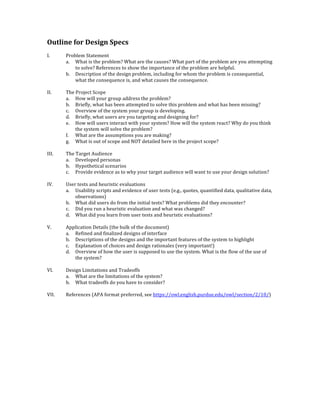Outline for design specs
- 1. Outline for Design Specs I. Problem Statement a. What is the problem? What are the causes? What part of the problem are you attempting to solve? References to show the importance of the problem are helpful. b. Description of the design problem, including for whom the problem is consequential, what the consequence is, and what causes the consequence. II. The Project Scope a. How will your group address the problem? b. Briefly, what has been attempted to solve this problem and what has been missing? c. Overview of the system your group is developing. d. Briefly, what users are you targeting and designing for? e. How will users interact with your system? How will the system react? Why do you think the system will solve the problem? f. What are the assumptions you are making? g. What is out of scope and NOT detailed here in the project scope? III. The Target Audience a. Developed personas b. Hypothetical scenarios c. Provide evidence as to why your target audience will want to use your design solution? IV. User tests and heuristic evaluations a. Usability scripts and evidence of user tests (e.g., quotes, quantified data, qualitative data, observations) b. What did users do from the initial tests? What problems did they encounter? c. Did you run a heuristic evaluation and what was changed? d. What did you learn from user tests and heuristic evaluations? V. Application Details (the bulk of the document) a. Refined and finalized designs of interface b. Descriptions of the designs and the important features of the system to highlight c. Explanation of choices and design rationales (very important!) d. Overview of how the user is supposed to use the system. What is the flow of the use of the system? VI. Design Limitations and Tradeoffs a. What are the limitations of the system? b. What tradeoffs do you have to consider? VII. References (APA format preferred, see https://owl.english.purdue.edu/owl/section/2/10/)

